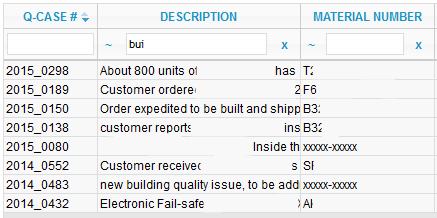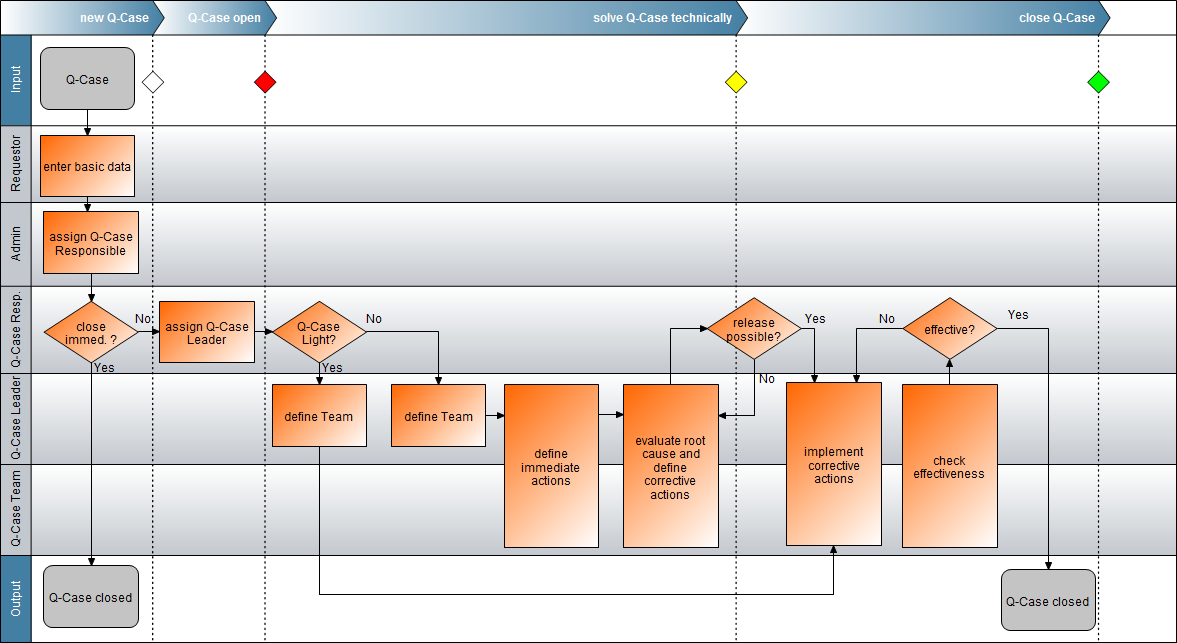The Concept
The requirements defined during the concept phase of the tool can be briefly summarized in four points:
- The hurdle to open a quality complaint shall be kept as low as possible
- There is a clear separation between the opening and the editing of a quality complaint
- The system should be as open as possible, so that everyone who can make a contribution to solving the quality complaint can do so without cumbersome registration or similar
- The conclusion of a quality complaint should undergo a formal approval process
Although that over time the requirements have further increased, the tool has remained true to these ideas.
The processing of quality complaints is carried out in four phases, which are recognizable by the background color of the quality complaint number:
- The color white means that a new quality complaint was opened, but no Q-Case responsible has been assigned yet
- The color red indicates that the team is currently working on the complaint; the issue has not yet been solved
- The color yellow indicates that the underlying problem has been resolved and an improvement measure was introduced - but it is still waiting for the verification of whether the measure was also effective
- The color green indicates that the case is solved, and the measures for improvement are verified and effective - the case is completely closed

GENERAL OPERATIONS
The input fields are defined in that way that the fields with a red font color are mandatory fields and fields with a blue font color are optional fields that can be filled, depending on the type of case or need. Date inputs are always done by clicking on the -icon, which is located right next to the input field. If the date field is a required field the date can only be selected but not deleted. If the date field is optional you can reset it by clicking the -icon - the date will be deleted.

If someone has entered data in the forms to edit the quality complaint and you want to switch to another form but the data has not been saved yet, the system issues a warning. This message can be ignored by clicking CONTINUE (this means you will lose any unsaved data), or by clicking CANCEL you will remain on the current form and can save the data.

Die meisten Tabellen, die im Tool verwendet werden, besitzen eine Fusszeile, mit der man die Daten in der Tabelle übersichtlicher darstellen kann.
Most of the tables that are used in the tool have a footer, which you can use to display the data in the table more clearly. Usually in the tables 100 lines of data is shown, however in the footer is also shown how many pages of 100 rows are available. By clicking on the arrows to the right and left you can do a paged scroll through the data. On the far right the total number of records is shown and for some tables there are more buttons available on the left side for manipulating the table.

Furthermore, most tables have below the column header fields that filter the records in the table. The filters are applied in sync with each keystroke and can be combined. The column header fields can also be clicked on to sort the table ascending or alternating by click.

To facilitate the operation of the tool all icons have so-called “Tooltips” defined, i.e. when you move your mouse over an icon a hint will appear to provide details on what the icon does.

EXPLANATION OF ROLES
The following roles or contributors are involved in the processing of a quality complaint and have the rights and duties as described here:
Creator
As the name suggests the creator opens Q-Case, but they can participate in the processing of the Q-Case or be informed of its progress
Quality
This role assigns newly opened Q-cases to a Q-Case responsible. The further processing of the Q-Case is then in the responsibility of the Q-case responsible. After the Q-Case responsible releases the complete closure of Q-Case, this role reviews the documentation to ensure that the measures are sustainable and clearly documented and then completes the closure of the Q-Case
Q-Case Responsible
The role of Q-case responsible is to designate the person who actively works and coordinates the quality complaint. He also monitors the progress of the Q-Case and assesses both, the technical completion of the case as well as the final closure. Ultimately, he has to assess the problem solving and is responsible for the sustainability of the corrective actions
Deputy Q-Case Responsible
A Q-Case responsible can define a representative for himself (a deputy). This representative then has the same rights as a real Q-case responsible with the restriction that he cannot convert a Q-Case to a Q-Case Light or a TOP Q-Case. Furthermore, he cannot change the Q-case responsible, except (if allowed by the delegating Q-Case responsible), that he can replace himself with another deputy from the same Q-Case responsible
Q-Case Leader
The Q-Case leader is the project leader of the Q case. He is responsible for coordination and resolution of the quality problem and the appropriate documentation
Q-Case Team
The Q-Case team supports the Q-case leader in solving the Q-Case, i.e. it works operationally on the appropriate topics, analyzes and implements immediate and definitive actions to prevent a recurrence of the issue
Other Users
The tool is designed so that anyone who has access to the tool can participate to solve the problem. E.g. everyone can track the progress and the solution and make a personal contribution to the solution without being officially nominated for the Q-Case team
Administrator
The Administrator has all rights in the system and in addition he/she can also change the configuration settings, define new roles, generate Back-ups etc.
FLOW CHART OF A QUALITY COMPLAINT
